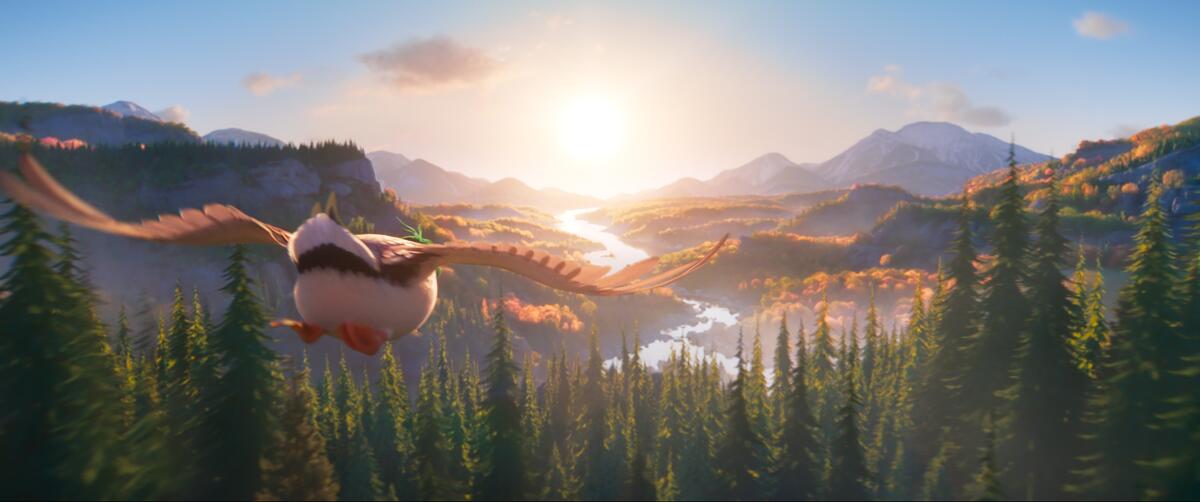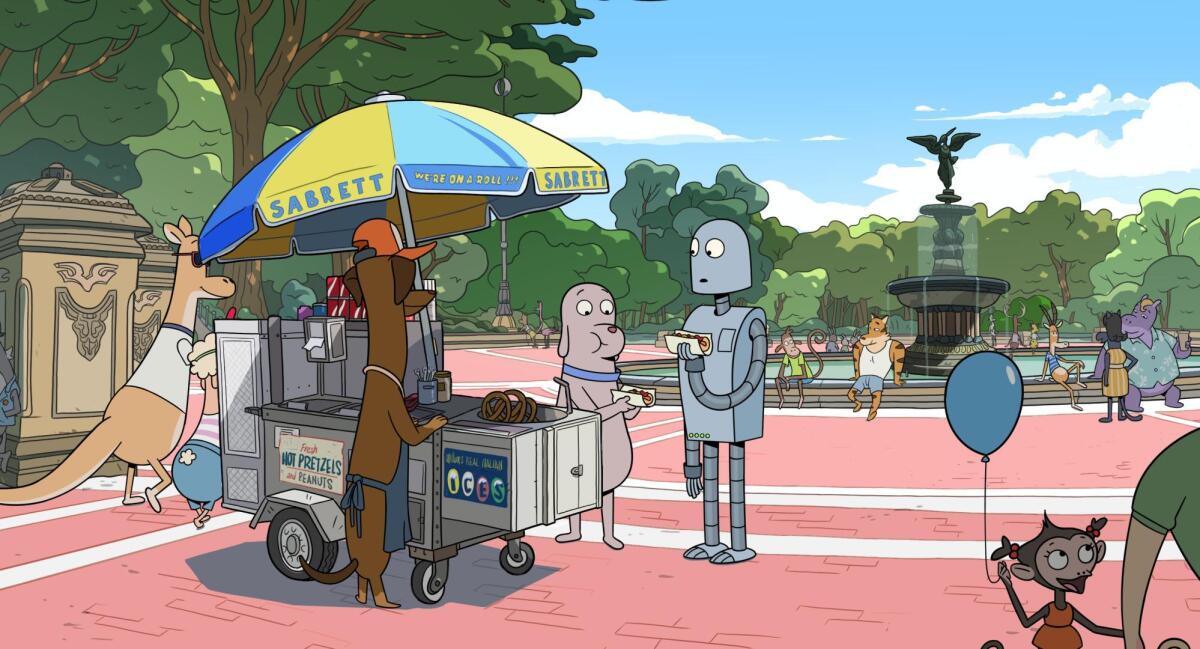Personal connections loom large in the animated ‘Migration’ and ‘Robot Dreams’

- Share via
In another big year for animation, 2023 saw the return from retirement of one its true masters (Hayao Miyazaki, with the acclaimed “The Boy and the Heron”) while an animated feature scored the year’s second-highest box-office haul (“The Super Mario Bros. Movie,” with $1.36 billion). Hollywood franchises continued (“Trolls Band Together”; “Spider-Man: Across the Spider-Verse”; “Teenage Mutant Ninja Turtles: Mutant Mayhem”) and another Japanese master, Makoto Shinkai, continued his critical and commercial winning streak with “Suzume.”
Meanwhile, two other notable releases took anthropomorphized animals down very different paths: The French-Spanish “Robot Dreams” and the American “Migration.”
“Despicable Me” studio Illumination took a step away from frenetically paced big-budget fare by partnering with French cartoonist and filmmaker Benjamin Renner on “Migration.” Renner’s gentle 2012 “Ernest and Celestine” was nominated for the animated-feature Oscar. His 2017 “The Big Bad Fox ... and Other Tales” may have been the funniest animated film of that year, retaining Renner’s signature 2-D hand-drawn style.
The tale of a duck family led by an overly cautious dad (voiced by Kumail Nanjiani) and steady mom (Elizabeth Banks) on its first-ever winter migration doesn’t feel like other Illumination offerings. Written by “The White Lotus‘” Mike White, it’s told at a slightly slower tempo, with beautiful vistas and characters rendered in a more watercolor-influenced style than the hard plastic look of the movies with Minions.
White says, “Kumail, to me, has a very Jack Lemmon quality — he’s like an Everyman with a heightened comic voice. Elizabeth is such a deft comedian and brought so much to it. The first time they came in and played with the material, I was blown away.”

There are genuinely funny — and scary — moments. There’s a Looney Tunes-inspired sequence in which a pigeon (voiced by Awkwafina) has, shall we say, extreme difficulties with New York traffic.
Renner says, “It used to be different. When she was first struck, it was a tire that was running over her, so she was completely flat, almost like, ‘She’s flat; she can’t be alive.’ So we reworked, reworked, reworked until we had the best way.”
Our BuzzMeter film experts are back to predict what Oscar voters will nominate in 10 Academy Awards categories. Vote in the online polls!
Explaining the inspiration for the film’s scariest scene, in which the little ducks are either held captive or generously helped by two ancient herons (one voiced by the inimitable Carol Kane), Renner tells a freaky tale from his own life. Traveling in Japan with his girlfriend, they ended up in a remote, mountain Airbnb.
“The only thing that was written on the ad was, ‘I am a cook.’ And I started thinking, ‘He’s cooking lost tourists.’ I started to freak out a little bit because of the mood and the mansion and [the language barrier]. The place is crowded with Victorian dolls with very beautiful hair. ‘He is going to cook us, that’s for sure. Then he’s transforming us into little dolls.’ I found a fire extinguisher that I slept with for the whole night.
“So we tried a version of the sequence like that and it turned out to be very funny and it also allowed me to meet Carol Kane, which was one of the best experiences ever.”
For the record, Renner survived his Japanese trip.

On the other end of the budget scale is the dialogue-free French-Spanish “Robot Dreams.” The hand-drawn charmer, based on Sara Varon’s graphic novel, evolves from a freewheeling look at the adventures of a dog and his robot friend to something much deeper as the tight-knit pair endure a lengthy separation.
Spanish writer-director Pablo Berger had only made live-action films before (his “Abracadabra” was in consideration for Spain’s 2017 official Oscar submission), but found himself so moved by the simply drawn pages, he couldn’t let it go.
“Making the film had an even more profound effect on me than I thought it would,” he says. “When I watch this film, I think of people I lost in the past. It made me very conscious to be a better friend.”
Still, the tonal shifts necessitated by the subject matter can be pretty wide swings — especially for an animated film about a dog and his robot that might draw young kids.
“The graphic novel wasn’t made for kids, though with the anthropomorphic characters, kids will love the design. But I made this film for adults. I made it for me as the primary audience.
“I definitely made a film about emotions. [Popular] animation normally deals with comedy and action. Of course, there’s comedy and action in ‘Robot Dreams,’ but I like to call it a ‘lasagna film.’ It has many layers. “There’s humor, but there’s a thick layer of emotion. When I got to the last pages of the book, I was moved and I was in tears. If, when it’s finished, the audience gets up and talks about the fragility of relationships and how we have to move on, how there are ways to heal by the use of memory, I will be very, very satisfied.”
More to Read
Sign up for The Envelope
Get exclusive awards season news, in-depth interviews and columnist Glenn Whipp’s must-read analysis straight to your inbox.
You may occasionally receive promotional content from the Los Angeles Times.












